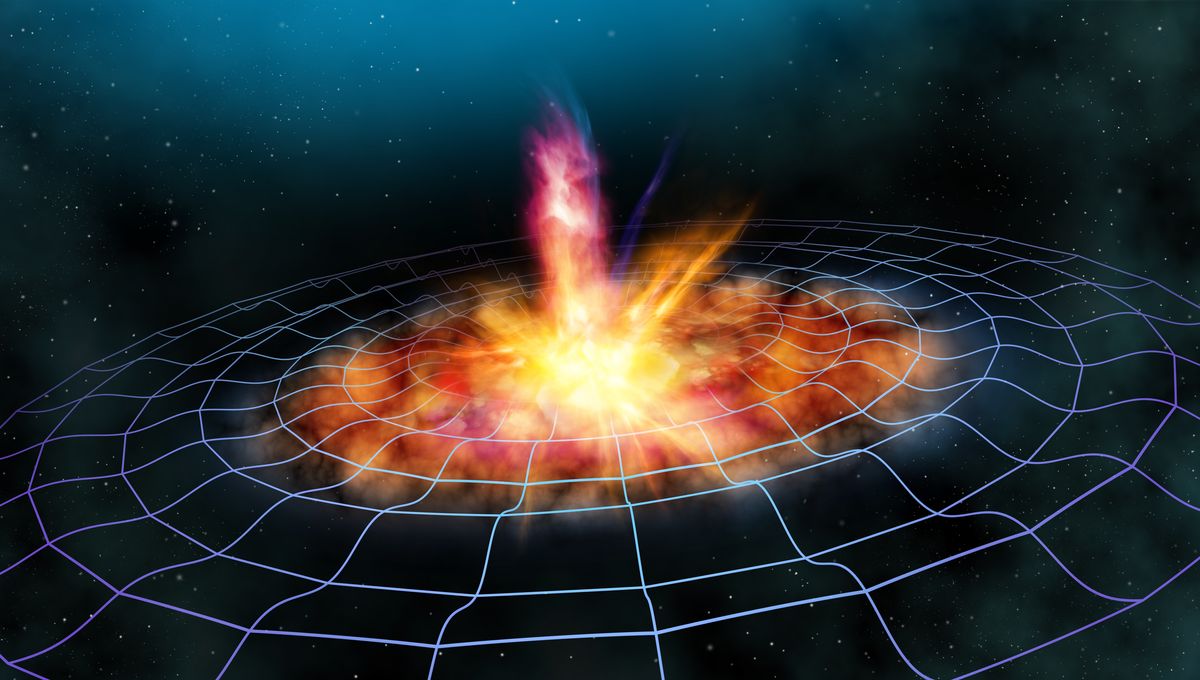
A preprint paper has made the case that humans owe our existence to gravitational waves – and that in a purely Newtonian universe, advanced life forms might not exist.
As far as we know, just a few elements are needed for life: hydrogen, carbon, nitrogen, oxygen, and phosphorus, with sulfur almost as ubiquitous. Some simple life forms seem to get by on these alone. The first was formed in the Big Bang, and the next three are the product of helium fusion within the lifespan of ordinary stars. Phosphorus has been detected in the supernova remnant Cassiopeia A, confirming astronomers’ confidence that, like many elements, it is formed in these stellar explosions. Supernovae also produce sulfur, as well as greatly increasing carbon and oxygen abundance, dispersing all these products widely.
Mammals rely on at least twenty elements to make our teeth, bones, and organs. The authors of a paper submitted to Proceedings of the National Academy of Sciences (PNAS), but yet to complete peer review, note that two of these are thought to take more than a supernova to make them, instead being a product of the r-process that occurs in kilonovae, the mergers of neutron stars.
This observation has been made before, but the authors point out that neutron star mergers are a product of gravitational waves. The chance of two objects as small and rare as neutron stars happening to run into each other in the vastness of the universe is vanishingly small.
Neutron stars are the product of supernovae not big enough to produce black holes. When two stars of 10-25 solar masses form in a binary system, each can become a neutron star. Provided neither explosion is so forceful as to expel the companion, the two will continue to circle each other.
It is here gravitational waves come into the picture. The powerful acceleration caused by the two exceptionally dense objects’ gravity interacting produces gravitational waves which carry energy away. The process releases so much energy we can detect its occurrence billions of light-years away. That energy has to come from somewhere, which is the mutual orbit of the neutron stars. Consequently, the orbit decays, with the pair spiraling inwards until they collide, producing a kilonova, and with it all the r-process elements.
Without gravitational waves, kilonovae would be far rarer than they are – the chance of one occurring in the lifetime of the Milky Way in a gravitational wave-less universe is remote. No kilonovae, no r-process elements, Professor John Ellis of Kings College London and co-authors propose. Since the r-process elements include iodine and bromine (both essential to humans), without gravitational waves, the argument runs, there would be no humans.
The chain of logic can be challenged at several points. Most obviously, it is plausible that if Earth was deficient in iodine and bromine our evolutionary path would have been different, but might not have precluded something resembling us. Humans depend on iodine supplied to the thyroid gland to regulate metabolism, among other things, and bromine for tissue development. Given millions of years, however, perhaps animals could have evolved to perform similar roles using other elements.
Such a hypothetical scenario is probably impossible to prove or disprove, unless we can find a large stock of planets that formed so remotely from any kilonova they are devoid of r-process elements. Even if we do it’s going to be a very, very long time before we can explore them for the presence of advanced life.
On the other hand, these two may not be the only r-process elements needed for humans. The authors note molybdenum is utilized by animals and plants alike to transfer oxygen atoms, and that thorium and uranium are probably the reason we have plate tectonics, arguably one of Earth’s essential characteristics.
Moving further up the chain one can question the iodine-kilonova connection. It is considered very likely kilonovae produce iodine, but it’s yet to be firmly established. Moreover, certain types of supernovae may also trigger r-processes, but this is still uncertain, and the quantities produced this way even more so.
The authors acknowledge this part of their reasoning has yet to be conclusively established. Moreover, a small portion of the Earth’s iodine comes from the s-process, for which gravitational waves are not required. The authors calculate that 4 percent of the Earth’s iodine has an s-process source – perhaps this would have been enough to sustain mammalian evolution if necessary.
At least part of the idea is testable in the nearer term. If the authors’ estimation of iodine’s origins are right, they say, there should be iodine-129 in material on the Moon’s surface. This is something we can look for the next time humans set foot on our satellite, hopefully only two years or so away.
Such investigations can advance science in unexpected ways. The authors note that the discovery of an asteroid or comet’s involvement in the extinction of the non-avian dinosaurs came out of efforts to test whether a nearby supernova had been responsible instead.
Carl Sagan famously said; “If you wish to make an apple pie from scratch, you must first invent the universe.” If you want a baker for the pie, you might need a specifically Einsteinian universe – but at this stage, it’s too early to tell for sure.
The preprint is available on ArXiv.org
[H/T Phys.org]
Source Link: To Make A Human, You Probably First Need A Gravitational Wave